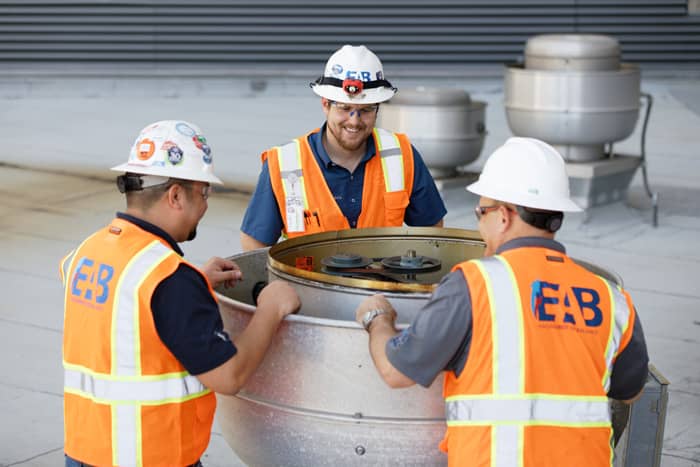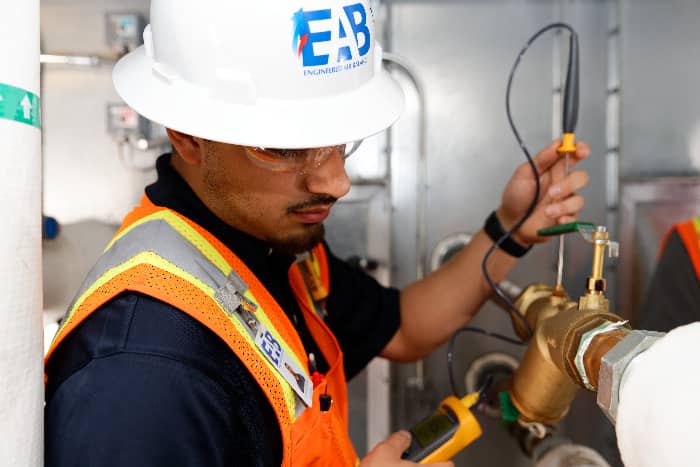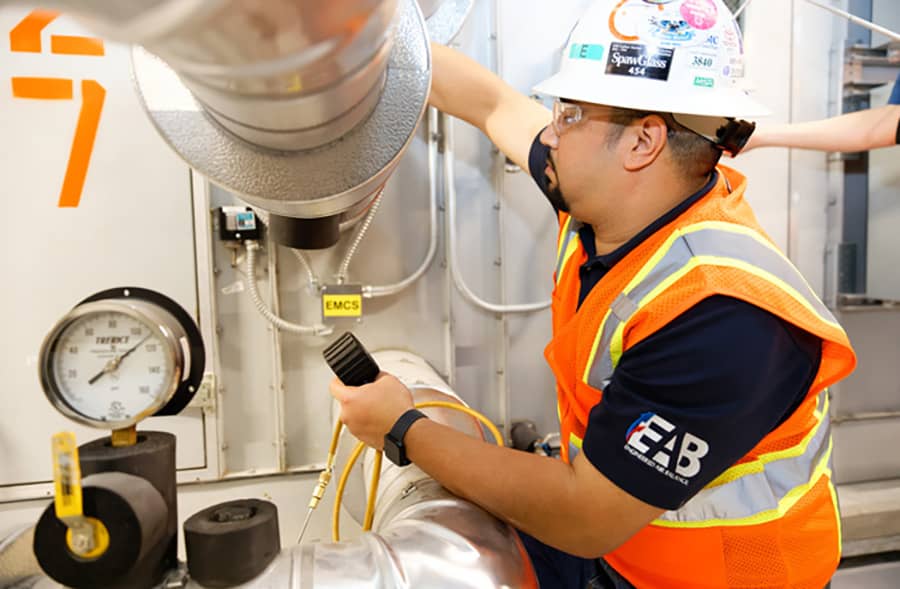
One of Engineered Air Balance’s primary objectives is to be a leader in delivering high-quality Total System Balance services in Texas and beyond. To achieve this, we provide thorough training for our technicians and engineers in HVAC Testing, Adjusting, and Balancing processes and techniques. Additionally, we supply our clients and construction teams with well-organized, comprehensive documentation to communicate our process and results.
EAB’s TAB technicians and engineers are committed to ensuring that a project’s engineering design intent is realized by its completion. This involves taking precise measurements and making calculated adjustments to each component of the heating and cooling system on a project. The data gathered during the air balancing process is compiled into a Test and Balance report, submitted at the project’s end. However, this report only reflects the results of our work and does not convey the planning steps necessary to complete all HVAC testing and balancing tasks successfully before the project deadline.
While smaller projects can be managed with simple notes and verbal communication, medium to large projects require advanced coordination between the construction team and the TAB team. This coordination is best facilitated by providing the construction team with a concise document containing all the relevant information needed to integrate the TAB process into the project schedule.
This concise document, known as a TAB Plan, should include several key pieces of information. At a minimum, a TAB plan should feature a detailed list of all equipment on a project, along with a context-specific list of prerequisites for the TAB process to commence. Additionally, the plan should describe the HVAC TAB process for each piece of equipment and provide an estimated timeline with manpower requirements for completing each test.
HVAC Test and Balance Prerequisites
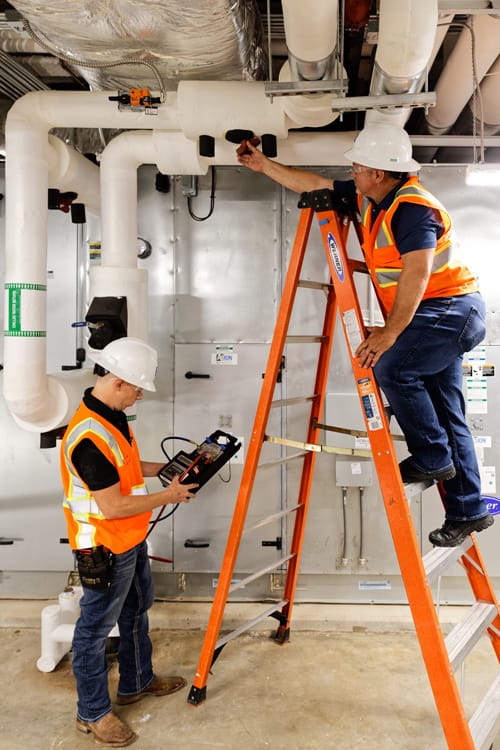
It is essential that the construction team understands the requirements for Testing, Adjusting, and Balancing HVAC systems so that the project can be prepared before the TAB team arrives. Below is a brief list of some HVAC TAB prerequisites and their importance.
Building Access
While straightforward on paper, building access can be limited in specific areas, especially in partially active buildings like hospitals. Therefore, it’s crucial for the construction team to coordinate building access before the HVAC Test and Balance team arrives, preventing potential delays caused by restricted access to equipment or control systems.
Installation and Startup Completion
Incomplete equipment startup is often the biggest hindrance to the TAB process. The complexity of modern HVAC systems means multiple trades must complete their work before a piece of equipment is fully operational. If any communication link breaks down, the startup process can be delayed. Often, the TAB team may be told that equipment is ready for testing, only to find something minor missing, derailing the process.
Controls Installed and Functioning
Even if equipment startup is complete, HVAC system balancing still requires the control system to be installed and operational. Although it’s occasionally possible to start the TAB process without functioning controls, it is far more efficient to balance equipment when it is running automatically, controlled entirely by the building’s control system.
Building Envelope Completion
An HVAC system’s function is to control air movement within a space. If the space has unsealed penetrations or improperly installed doors and windows, achieving efficient temperature, pressure, or indoor air quality control becomes nearly impossible. Therefore, it is crucial to ensure all penetrations are sealed and doors and windows are correctly installed, particularly in spaces where pressure control is vital, such as operating theaters or isolation rooms.
Testing Adjusting and Balancing Process and Timeline
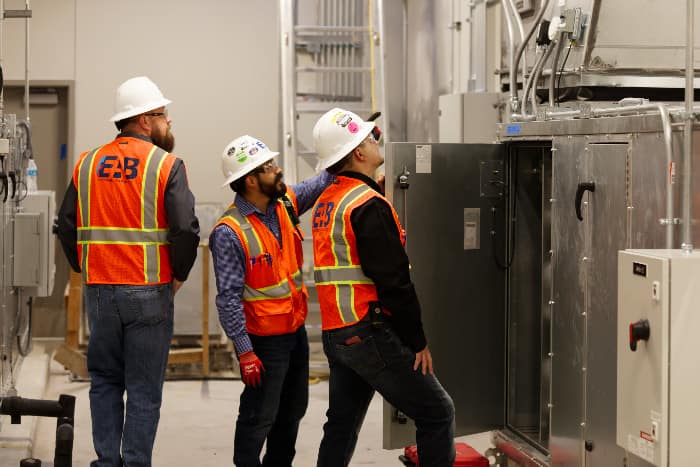
To aid the construction team in making informed decisions while integrating TAB into the project schedule, it is important to communicate the testing and balancing tasks along with the estimated timeline and manpower requirements. Incorrect assumptions about the scalability or workflow of the test and balance process can lead to unrealistic deadlines, potentially impacting city or state inspections. The TAB plan should include specific steps for each piece of equipment, estimated time for each step, manpower required, and any prerequisites for subsequent steps. This information helps the construction team understand the duration of TAB tasks, potential parallel tasks, and efficient scaling of the TAB team to meet deadlines.
EAB’s TAB Plan Outline
The typical TAB plan provided by EAB consists of at least four sections: “Pretesting Requirements,” “Testing, Adjusting, and Balancing (TAB),” “TAB Plan Outline,” and “TAB Report Outline.
The Pretesting Requirements section lists all prerequisites that must be completed before TAB can begin, including both simple tasks like ductwork installation and complex tasks specific to certain equipment.
The Testing, Adjusting, and Balancing (TAB) section outlines the general workflow for the project, including estimated duration and manpower needs. This section may also indicate which TAB tests can be performed in parallel and which must be completed sequentially.
The TAB Plan Outline section details all types of equipment and the balancing steps specific to each. It includes pre-balancing steps, like presetting damper positions, as well as the final balancing steps required for each piece of equipment.
The TAB Report Outline section provides a sample report table of contents and sample field data forms, giving the reader an idea of what to expect from EAB’s final TAB report. The final report contains three main sections: the “Front End,” the “Report Data,” and the “Appendix.” The “Front End” includes a title page, table of contents, project summary, and a list of the instrumentation used. The “Report Data” section is organized by system, detailing all recorded data during the TAB process. The “Appendix” contains all relevant project documentation, including schedules, submittals, drawings, and correspondence, along with a complete Deficiency Resolution Log (DRL).
Deficiency Resolution Process
The final section of the TAB report, the DRL, records deficiencies based on engineering document requirements. The DRL is periodically submitted to the customer or construction team, who then notify EAB when a deficiency is resolved. EAB verifies the resolution and marks it complete or incomplete, documenting each backcheck on the DRL. Unresolved deficiencies are included in the final TAB report as Action Items or Info items, depending on project requirements. A complete copy of the DRL, with all open and closed items, is included in the final TAB report appendix.
Conclusion
Testing, Adjusting, and Balancing is a crucial service for many construction projects. The best way to integrate the TAB process into the project schedule is by providing a well-documented plan to the construction team during the planning phase, long before the TAB team arrives on site. A TAB Plan is an organized document designed to provide all necessary information to assist the construction team in integrating TAB into the project schedule effectively. When executed well, a TAB plan can significantly enhance the project’s outcome.

